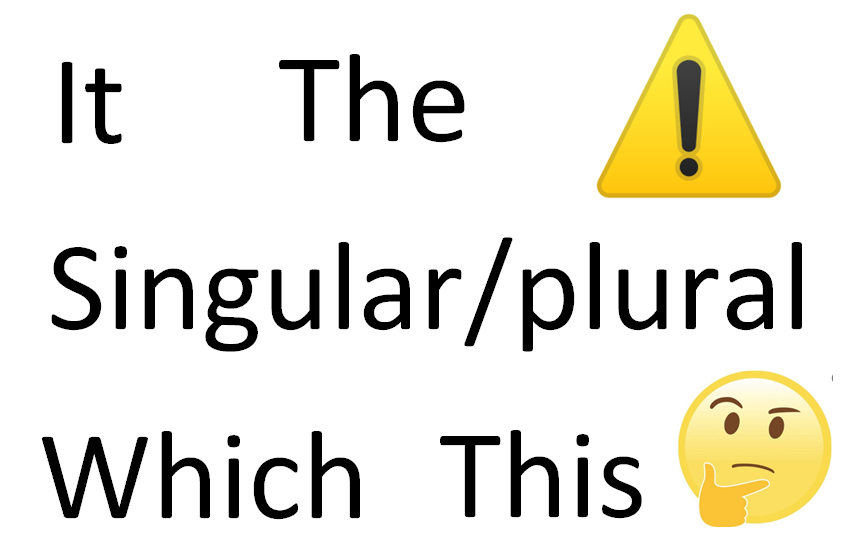Five common small writing mistakes that destroy an article
Very often, we have writing mistakes that seem to be small. However, those mistakes significantly damage our articles.

Very often, we have writing mistakes that seem to be small. However, those mistakes significantly damage our articles.
Those small mistakes do not appear clearly and are difficult to observe. Because, sentences that have these mistakes are grammatically or structurally correct, but have very ambiguous meanings.
The damage to the articles is mainly due to ambiguous or unclear meanings that the mistakes cause.
Ambiguous sentence is a sentence that can be understood in more than one ways by different readers.
In scientific writing, ambiguous or unclear meanings can cause significant misleading toward results or conclusions.
Here are the five common small mistakes that we really should avoid in writing.
1. Singular or plural forms of object and subject
In writing, we need to correctly select the correct forms for the subject and object in a sentence. The form for subject and object can be either singular, plural or none of them (as an independent word).
Yes, all the people already know what singular and plural forms are. However, many of them still make mistakes in their writing regarding these singular or plural forms causing their articles to be severely misunderstood.
Defining a subject or object as a singular/plural or independent word has a significant difference in an article.
We should make a subject or object in singular or plural forms if the subject or object still has a general meaning or is not yet referred to elsewhere in an article.
Meanwhile, a subject or object can be an independent word if the subject or object is already well-known or has a general meaning.
Example:
“To model random variables in our study, we use discrete statistical distribution”
The phrase “discrete statistical distribution” when we write in this form is not clear. Because, there are many types of discrete statistical distributions, for example, binomial, discrete uniform, geometric and poison distributions.
When we write a sentence like the above, it means that we are using all types of discrete distributions. Hence, readers will get confused and cannot justify the scientific method used in our article containing the sentence.
We can use “discrete statistical distribution” when we explain the definition of discrete distribution that is applicable in general.
For example: “discrete statistical distribution” is a type of statistical distribution that has variables with a countable number of outcomes.
In the example above, we use the plural format of “random variables”. This plural format means that the variables are still general and not yet specifically known in the context so that readers do not need to associate the variables into a specific context.
The sentence should be:
“To model random variables in our study, we use a discrete statistical distribution”
In this sentence, we clearly say that we only use a type from many possible discrete distributions. Although, we still do not say specifically what discrete distribution we use (commonly will be explained in the following sentences).
2. Ambiguous use of “it”
It is very common to use “it” to refer to something in an article. However, a wrong use of “it” can make sentences to be ambiguous and unclear.
Unclear or ambiguous sentences can make readers having difficulty to follow or understand the meaning of the sentences.
Example:
“A special polymer material is used in our experiment and is melted with another polymer material. It has a high thermal resistance property”
By default, it will refer to “another polymer material”. However, many times, we want to associate “it” with “a special polymer”.
It can be a big misleading if readers think that “another polymer material” has a high thermal resistance property when “a special polymer material” is the one that has the high thermal resistance property.
This ambiguity is a fundamental mistake in scientific writing!
In scientific writing, a sentence should be clear and obvious so that there is only one interpretation by readers.
The sentence should be:
“A special polymer material is used in our experiment and is melted with another polymer material. The special polymer has a high thermal resistance property”
In this sentence, we clearly state that the special polymer has a high thermal resistance property. In this case, we need to repeat the word “special polymer” to make the sentence clear and obvious.

3. Ambiguous use of “This”
Very often, we only use “this” to refer to previous objects or words in an article. It is very common to use “this” to avoid repetitions and make a sentence shorter.
However, only using “this” to refer to previous words can lead to significant ambiguity and make a sentence becomes scientifically weak.
It is not true to only use “this” to avoid repetitions in writing.
The most important thing in scientific writing is clarity (as being explained in example 2 above). Clarity in writing cannot be compromised for whatever reasons, although if we need to repeat words!
Example:
“The handling procedure to transfer soft materials is by packaging the materials into a special compartment. This is done by using an automated system”.
“This” refers to handling or packaging? Very often, people will refer “this” to packaging, but it is not always the case. In many cases, we want “this” to refer to handling.
The sentence should be:
“The handling procedure to transfer soft materials is by packaging the materials into a special compartment. This handling is done by using an automated system”.
In this sentence, it is obvious that we refer to the handling procedure.
4. Incorrect use of “the”
“The” is always found in almost any article. “The” is used to tell a word or context that has been discussed before or already known before by readers (either in a text or well-known in general, for example, “the earth”, “the globe” and “the UK”).
Instead, very often, mistakes in using “the” are very common to be found when “the” is combined with singular/plural forms of a word. These mistakes will make a paragraph difficult to follow and understand.
Example:
“The mechanism of combustion engines is the ignition of high-pressure fuels, by using a spark plug, in a combustion chamber”
When we say “The mechanism of combustion engine”, this sentence means that the mechanism applies to all types of combustion engine.
In fact, the use of spark plugs only applies to petrol engines and not to diesel engines. Because, for diesel engines, the spark is from the self-ignition of high-pressure diesel fuel. The mechanism will also be different from any other combustion engine, for example, aero-jet engine.
The sentence should be:
“The mechanism of petrol combustion engine”.
Alternatively, “a mechanism of combustion engine”.
In these forms, it is clear that “the mechanism” applies only to petrol engines or a specific type of combustion engine (not all types of combustion engines).
5. Incorrect location of “which”
We often use dependent clauses to explain more about main clauses. In particular, dependent clauses are used when a specific or important term needs to be clarified.
“Which” is very often to make a dependent clause that explains a word in a main clause. However, many mistakes are in placing a dependent clause inside a main clause.
Misplacing dependent clauses in main clauses can cause readers to misunderstand a term and then can mislead the readers.
Example:
“Our method is more efficient than the previous method which avoids the use of additional steps”
This sentence means that the “previous method” is the one that avoids additional steps. In fact, what we mean is that “our method” that avoids additional steps.
Another common mistake is by writing like this:
“Our method is more efficient, which avoids the use of additional steps, than the previous method”
In this form, the sentence is also incorrect because the sub-clause “which avoids the use of additional steps” refers to the words “more efficient” and is meaningless.
A sub-clause should be placed directly after a word that the sub-clause explains.
The sentence should be:
“Our method, which avoids the use of additional steps, is more efficient than the previous method”.
In this form, it is clear that “our method” that avoids additional steps.
Conclusion
In writing, we should not overlook small mistakes in the use of “singular/plural forms”, “it”, “this”, “the” and “which” words.
People argue that they already know these forms or words. Yet, many of them still incorrectly use the forms and words.
These small mistakes unexpectedly can destroy a scientific article. Because, the mistakes cause ambiguity and misunderstanding about the content of the article.
So, we need to avoid the mistakes and make clear and unambiguous sentences when writing a scientific article (or any other article).
We sell all the source files, EXE file, include and LIB files as well as documentation of ellipse fitting by using C/C++, Qt framework, Eigen and OpenCV libraries in this link.
We sell tutorials (containing PDF files, MATLAB scripts and CAD files) about 3D tolerance stack-up analysis based on statistical method (Monte-Carlo/MC Simulation).